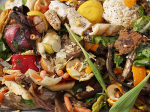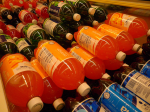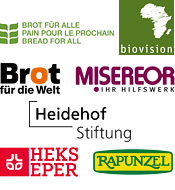News
13.04.2016
Joint opposition against Syngenta's patent on conventionally bred tomato

In 2015, Swiss agrochemical giant Syngenta was granted a patent on a tomato derived from classical breeding but a broad coalition of organisations has now started a joint opposition in an effort to achieve the revocation of the patent. The European Patent Office (EPO) granted Syngenta a patent for a tomato with a higher content of compounds called flavonols. Flavonols are known for their health benefits and are said to help prevent cardiovascular diseases and certain cancers. Patent EP1515600, which was published in the August 12th issue of the European Patent Register, covers the tomato plants, seeds and fruits. The “invention” is described as “flavonol expressing domesticated tomato and method of production”. However, the tomato was simply developed by crossing wild tomatoes from Latin America with domesticated varieties and is thus not genetically engineered. Although European patent law prohibits patents on plant varieties and classical breeding methods, the Enlarged Board of Appeal of the EPO ruled in March 2015 in a controversial decision on the precedent cases of broccoli and tomato, that plants obtained by “essentially biological processes” are patentable. The EPO has already granted about 180 patents on plants derived from conventional breeding and about 1400 such patent applications are still pending. The coalition “No Patents on Seeds!”, which is supported by many non-governmental and farmers’ organisations from all over Europe, strongly disapproves of this practice which they consider an unacceptable interpretation of European patent law. In their oppositon against Syngenta’s patent they argue that it is a well known fact that lines of wild tomatoes can be crossed with commercially traded varieties. Thus, the processes covered by the patent and the resulting plants are not an invention. The organisations warn that the patent would provide a monopoly on all plants with the respective characteristics, the seeds and even the fruits and food derived thereof. They regard the patent a case of biopiracy. The signatures against the tomato patent will be collected and then handed over to a patent lawyer who will file a joint opposition. With this appeal, the organisations of "No Patents on Seeds!"also want to send a strong political signal against all patents on life in general, especially on plants and animals. (ab)
11.04.2016
Reducing food waste could cut emissions from agriculture by 14%, study shows

One tenth of global greenhouse gas emissions from agriculture could easily be avoided in the future by putting an end to food loss and waste, scientists said on Thursday. The new study from the Potsdam Institute for Climate Impact Research (PIK) provides food loss estimates at national and global level while also calculating the associated emissions. Each year, one third of global food production is lost after harvest or wasted in retail and households. “Currently, 1.3 billion tons of food per year are discarded,” explains Jürgen Kropp, co-author and deputy chair of Climate Impacts and Vulnerabilities at PIK. While food losses occur mostly in developing countries due to less efficient agricultural infrastructures, food waste is mainly a problem in industrialised countries. And the amount of food wasted will increase dramatically if more countries adopt western food habits. “As many emerging economies like China or India are projected to rapidly increase their food waste as a consequence of changing lifestyle, increasing welfare and dietary habits towards a larger share of animal-based products, this could over proportionally increase greenhouse gas emissions associated with food waste – at the same time undermining efforts for an ambitious climate protection,” Kropp warns. According to the researchers, emissions from agriculture are expected to rise by up to 18 gigatons of CO2 equivalents by 2050. Over the same time, emissions linked to food waste could increase from currently 0.5 to 1.9-2.5 gigatons of CO2 equivalents per year, the study shows. “Thus, emissions related to discarded food are just the tip of the iceberg,“ explains co-author Prajal Pradhan. “However, it is quite astounding that up to 14 percent of overall agricultural emissions in 2050 could easily be avoided by a better management of food utilisation and distribution,” he added. The scientists found that over the last five decades food availability has rapidly increased while global average food demand per person has remained almost constant. Richer countries tend to consume more food than is healthy or simply waste it, they said. At the same time, hunger and malnutrition are still a problem in many developing countries because many people do not have access to food or because food loss occurs. “Avoiding food loss could pose a leverage to various challenges at once, reducing environmental impacts of agriculture, saving resources used in food production, and enhance local, regional, and global food security,” Kropp said. (ab)
05.04.2016
New UN Decade aims to eradicate hunger and malnutrition

The UN General Assembly has proclaimed a ‘Decade of Action on Nutrition’ that will run from 2016 to 2025 in an effort to reduce hunger and malnutrition. World governments adopted a resolution in New York on April 1. The decade has the aim of providing an umbrella for a wide group of actors and initiatives working together to address nutrition issues over the next ten years. “Clearly, not enough is being done to ensure the basic right to food,” said Brazil's Permanent Representative to the United Nations, Antonio de Aguiar Patriota. It was simply unacceptable for chronic hunger, malnutrition and food insecurity to occur in a world that produced enough food for all of humanity, he said. Worldwide, almost 800 million people are chronically undernourished and over two billion suffer from micronutrient deficiencies. At the same time, about 1.9 billion people are overweight, of whom 600 million are obese. The resolution also focuses on the 159 million children under the age of five who are stunted, being too short for their age, and the 50 million children who are wasted, being too low in weight for their height. “Children can’t fully reap the benefits of schooling if they don't get the nutrients they need; and emerging economies won't reach their full potential if their workers are chronically tired because their diets are unbalanced. That's why we welcome the Decade of Action on Nutrition and look forward to helping make it a success,” said José Graziano da Silva, Director-General of the Food and Agriculture Organisation (FAO). Together with the World Health Organisation, FAO is to lead the implementation of the Decade. “This resolution places nutrition at the heart of sustainable development and recognizes improving food security and nutrition are essential to achieving the entire 2030 Agenda,” Graziano da Silva added. Goal 2 of the 2030 Agenda for Sustainable Development aimes at ending hunger, achieving food security and improved nutrition, and promoting sustainable agriculture. (ab)
04.04.2016
Biofuels lead to increasing competition for land and water, study warns

The growing production of biofuels is leading to increased competition for land and water that could otherwise be used for food production, new research shows. According to a study published in March in the Nature journal “Scientific Reports”, the arable land and water now used for the production of bioethanol and biodiesel could produce sufficient food to feed about 280 million more people. “We are investigating and evaluating the effects of biofuels on food security – the food-energy nexus – and its link with the global appropriation of land and water,” said Paolo D’Odorico, a professor at the University of Virginia who co-wrote the paper with colleagues from Italy and the US. “The land and water resources claimed by biofuel production have been poorly quantified, and we are trying to gain better understanding to help inform public policy.” The researchers based their analysis on biofuel data by the UN Food and Agriculture Organisation and other sources and estimated the water and land footprints per unit of biofuel energy. Their findings show that first generation biofuels (i.e. produced from food crops) in 2013 claimed an area of about 41.3 million hectares, which accounts for about 4% of the global surface of arable land. In addition, biofuel production consumed 216 billion m3 of water, which corresponds to about 3% of the global water consumption for food production. The researchers determined that these resources, if used for the cultivation of food crops, would be sufficient to feed about 280 million more people – about one third of the undernourished people in the world. However, the authors stress that this is not the number of people that would likely get access to food should biofuel use be reduced to zero since the availability of food alone does not ensure that poor people will have enough to eat. The findings suggest that with the world’s population projected to grow to about 9 billion by the middle of the century, the need for food and fuel could increasingly be at odds. The study shows that if biofuel production for transportation were to be increased to 10 percent of the total fuel used by the transportation sector – in line with recent policy and business patterns that encourage renewable energy production – the planet could meet the food needs of only about 6.7 billion people. “These results clearly show the extent to which biofuels are competing with food for the limited land and water resources of the planet, and are becoming an additional obstacle to bringing food production in line with the increasing needs of the human population,” D’Odorico said. According to the authors, first generation bioethanol is still the major contributor to the global biofuel supply while the production of second and third generation biofuels from cellulosic plant tissues or algae or new technologies relying on agricultural waste are overall still negligible. (ab)
01.04.2016
More effort needed to protect wild relatives of food crops, study finds

Wild relatives of vital food crops, which have useful traits that could help farmers adapt to climate change, are poorly represented in seed banks, new research shows. In a paper, published in the journal Nature Plants on March 21, an international team of scientists warns that more needs to be done to collect and conserve wild relatives of plants for future generations. “The world's food supply is in a precarious position of depending on too few crop plant species,” said co-author Colin Khoury, a scientist at the International Center for Tropical Agriculture. The researchers mapped more than 1,000 crop wild relatives of 81 essential food crops, and found that for 29.1% of total taxa associated with 63 crops, no samples exist, and a further 23.9% of crop wild relatives are represented by fewer than ten accessions in gene banks. According to the study, more than 70% of wild plants considered high priority for collection are underrepresented in gene banks. These included the gene pools of crops important for agricultural production, for example sugarcane, sugar beet and maize as well as important regional staple crops, such as banana and plantain, cassava, sorghum, yams and cowpea. High priority was also assigned to the gene pools of crops important for smallholder income generation in the tropics (for example, cacao and papaya) and minor crops increasing in popularity because of their nutritional qualities such as quinoa. “Over the history of agriculture - from Neolithic times onwards - farmers have been whittling down the diversity available in wild plants to focus on a particular subset of that diversity that we call the domesticated crop,” explained co-author Luigi Guarino, director of science and programs at the Global Crop Diversity Trust. “This domesticated crop is just a selection from a much wider diversity of genes, traits and adaptations that are out there still in the ancestors and relatives of the crops we use today,” he added. The wild relatives of domesticated crops possess characteristics such as drought and heat tolerance or increased pest and disease resistance that could be used for breeding more resilient crop varieties. But there are lots of threats to genetic diversity, such as land-use change, urbanisation, deforestation and climate change itself. The assessment also shows that over 95% of crop wild relatives are insufficiently represented in regard to the full range of geographic and ecological variation in their native distributions. The most critical collecting gaps occur in the Mediterranean and the Near East, western and southern Europe, Southeast and East Asia, and South America. The scientists conclude that a systematic effort is needed to improve the conservation and availability of crop wild relatives. But they stressed that it is also important to conserve this diversity in nature itself, allowing it to continue evolving. “This is difficult to do, especially under climate change which is already causing movement of species polewards and to higher elevations,” Luigi Guarino told BBC. (ab)
23.03.2016
Italian parliament passes new law to fight food waste

The Italian parliament has approved a new law aimed at reducing food waste. The bill, which was passed on Thursday with an overwhelming majority of 277 votes in favour, will make it easier for supermarkets and farmers to donate to charities. “The main objective of the new law is to give incentives to save food and to double the amount of food that is donated to charities,” Maria Chiara Gadda, the Democratic Party MP who introduced the bill, told the Italian newspaper La Repubblica. The new law will cut red tape which is currently making it difficult for food stores, supermarkets or restaurants to donate excess food since donations must be declared five days in advance. Under the new rules, retailers would only have to declare all their donations by the end of the month. Italy is now the second European country after France to pass a food waste law. But unlike the French law, which introduced heavy fines of up to €75,000 for supermarkets that throw away unsold food, the Italian approach is to incentivise surplus product donations by lowering the bureaucratic burden of food donations and offering tax cuts. “We are making it more convenient for companies to donate than to waste,” Italian agriculture minister Maruizio Martina told La Repubblica. According to food producers’ organisation Coldiretti, Italy throws away 5.6 million tonnes of food every year worth an estimated €12.5 billion. Most food is thrown away in private households, while restaurants account for 21%, food retailers for 15%, agriculture for around 8% and processors for 2%, according to a study by the university Politecnico di Milano. The bill will also make it possible for businesses to give away food which is past its 'sell by' date, if it is still edible. Italy will also invest in a campaign to promote the use of 'doggy bags' in restaurants, encouraging diners to take their leftovers home. The bill also includes provisions for collecting and transporting produce left in fields by farmers after harvest. The recovered food will be passed on to the six million Italians who rely on food donations from charities to eat. “We currently recover 550 million tonnes of excess food each year but we want to arrive at one billion in 2016,” said Maurizio Martina. “Today’s vote confirms the that Italy is at the forefront in the fight against food waste.” The bill now needs to pass the Italian Senate to become law. (ab)
21.03.2016
UK to introduce sugar tax in an effort to fight childhood obesity

Britain will introduce a sugar tax on soft drinks in an effort to prevent childhood obesity. The new tax will enter into force in 2018, Chancellor George Osborne announced on Wednesday. The levy, which will be imposed on companies that produce or import soft drinks, is expected to raise 520 million pounds a year (about €670 million). The money will be used to fund sports programs and breakfast clubs at primary schools and allow many secondary schools to extend their school day. “Five-year-old children are consuming their body weight in sugar every year. Experts predict that within a generation over half of all boys and 70% of girls could be overweight or obese. Obesity drives disease,” the chancellor told MPs on Wednesday. The tax will consist of a two-part levy, with rates depending on the amount a sugar a drink contains. A lower tax will apply to beverages with a sugar content of more than 5 grams of added sugar per 100 milliliters, the higher levy will be imposed on drinks with over 8 grams of added sugar, which includes Coke and Pepsi. Pure fruit juice and milk will be excluded from the tax, which will start in April 2018. Doctors and health campaigners, who had long been calling for a sugar tax, welcomed the move. Simon Stevens, chief executive of National Health Service (NHS) England, told The Guardian that the tax “will send a powerful signal and incentivise soft drinks companies to act on the health consequences of their products”. British celebrity chef Jamie Oliver, who has for years been pushing for the soda tax, said in a statement: “The food revolution is underway. This feels like a victory for Britain’s children and for everyone who has campaigned so hard for a tax on sugary sweetened drinks.” With the new tax, Britain will follow other countries that have started taxing sugary drinks to reduce consumption, especially among children. Mexico, one of the top countries for childhood obesity, introduced a 10 per cent tax on soft drinks in 2014. Since then, sales in Mexico have fallen by 12 per cent. (ab)
16.03.2016
Cutting U.S. food waste could save the environment and generate $100bn

Food waste in the United States amounts to a staggering 63 million tons per year. A new report released last Wednesday now shows an achievable path to a 20% reduction of food waste within a decade through 27 cost-effective, feasible, and scalable solutions. Published by ReFED, a collaboration of business, nonprofit, foundation and government leaders committed to reducing US food waste, the report comes just a few months after the U.S. government set a national goal calling for a 50% cut in edible food waste by 2030. According to the “Roadmap to Reduce US Food Waste”, the U.S. spends more than $218 billion a year or 1.3% of GDP growing, processing, transporting and disposing food that is never eaten. Each year, 52.4 million tons of food is sent to landfill, and an additional 10.1 million tons is discarded or left unharvested on farms. This food waste consumes 21% of all fresh water, 19% of all fertilizer, 18% of cropland and 21% of landfill volume. The measures proposed in the report would require $18 billion of investment over the next decade but would yield a net economic value to society of approximately $100 billion over the same period through consumer savings on lower food bills, additional meals donated to the hungry, and additional values of reducing greenhouse gas emissions. “Reducing food waste is one of the most tangible ways we can all help contribute to a healthier planet. What is so exciting about the Roadmap is that it clearly identifies actions that can be taken today, which will provide immediate economic benefits to consumers and businesses,” said Sarah Vared, interim director of ReFED. The proposed solutions prioritise prevention first, then recovery, and finally recycling. According to the authors, solutions that prevent waste in businesses and homes have the greatest economic value per ton and net environmental benefit, diverting 2.6 million tons of annual waste. Prevention measures include conducting large-scale advocacy campaigns to educate consumers about ways to prevent food waste, modifying packaging sizes and standardizing food label dates, including eliminating visible “sell by” dates to reduce consumer confusion. Opening retail stores that sell discounted groceries, such as the supermarket recently opened in Denmark which sells unsold food donated by supermarkets and businesses at a lower price, are another way to prevent waste. Food recovery by redistributing food to people could increase by 1.8 billion meals annually, nearly doubling the amount of meals rescued today and diverting 1.1 million tons of waste. Recycling by repurposing food waste as energy, agricultural and other products also offers a huge savings potential. Measures include composting or feeding food waste to animals. The report claims the implementation of the proposed 27 solutions could avoid nearly 18 million tons of greenhouse gas emissions annually and could save the country 1.6 trillion gallons of fresh water. (ab)
14.03.2016
Study: Sub-Saharan Africa needs to adapt to climate change, staple crops at risk

Agricultural systems in sub-Saharan Africa need to undergo urgent transformations as climate change will pose a significant threat to key food crops, according to new research published on 7 March in the journal Nature Climate Change. The study examines the likely effect of different climate change scenarios on nine staple food crops that constitute 50% of food production in sub-Saharan Africa. “This study tells where, and crucially when, interventions need to be made to stop climate change destroying vital food supplies in Africa,” says lead author Julian Ramirez-Villegas, who works with the International Center for Tropical Agriculture (CIAT). “We know what needs to be done, and for the first time, we now have deadlines for taking action,” he adds. If no adaptation actions are taken, for example switching crop types, improving irrigation systems, or in extreme cases moving away from farming, climate change could place the food security and the livelihoods of smallholder farmers at risk, the authors warn. Maize, beans and bananas will be most at risk. Up to 30% of areas growing maize and bananas, and up to 60% of the areas growing beans are projected to become unsuitable for production by the end of the century. The study suggests that almost 1.85 million hectares of current bean cropping systems in Uganda and Tanzania, where more than 40% of sub-Saharan Africa’s bean supply are grown, will be unable to do so by 2100. In other regions, transformations will need to take place earlier. Banana growing regions in West Africa and maize growing regions in Southern Africa, for example Namibia, Botswana or Zimbabwe, will need to adapt within the next ten years. Adaptation strategies need to differ across sub-Saharan Africa, respecting the different local conditions. The authors conclude that traditional varities of millet, sorghum, cassava, groundnut and yams can be viable alternatives since they have a higher tolerance to heat and drought. Other measures include improving irrigation options, making agro-climatic advisory services available to farmers and exploring other livelihood strategies, such as the introduction of livestock. But the authors also underline that there are promising examples of successful adaption efforts. In Uganda, for example, intercropping banana with coffee has been found to raise incomes of farmers by 50% and makes them more resilient to climate change impacts. (ab)
09.03.2016
Glyphosate: EU vote on extending licence of weedkiller ingredient postponed

The European Union has postponed a decision on relicensing glyphosate after a dispute over whether the controversial weedkiller ingredient causes cancer. A vote on authorising glyphosate for use in the EU for another 15 years by a standing committee for the European Commission was put off on Tuesday due to opposition from a number of member states. Sweden, France, Italy and the Netherlands announced they would be voting against the relicensing of glyphosate. Germany planned to abstain from any vote because the country’s environment and agriculture ministries could not agree on a common position. According to news agency Reuters, Commission sources said the meeting stopped short of a vote. “We would like a solid majority to take a decision on this kind of issue and some member states had sceptical observations that we will have to answer, so it [a postponement] was the wise thing to do,” a commission spokesperson was cited by The Guardian. The European Commission proposal was to extend the authorisation of glyphosate until 2031. Glyphosate is the most widely used weedkiller worldwide and the main ingredient in Monsanto’s Roundup brand of herbicides. In March 2014, the International Agency for Research on Cancer (IARC), an arm of the World Health Organisation, classified glyphosate as “probably carcinogenic to humans”. However, the European Food Safety Authority (EFSA), which advises EU policymakers, concluded that glyphosate is “unlikely to pose a carcinogenic hazard to humans”. Martin Häusling, agriculture and public health spokesperson of The Greens, welcomed the decision to postpone the vote: "The growing opposition among EU governments to reapproving glyphosate for use in the EU is encouraging. Given the serious health and environmental concerns and conflicting scientific advice regarding glyphosate, as well as the public opposition, it is welcome that EU governments are belatedly waking up to the problem.” He said that as long as there are serious health concerns and conflicting scientific opinions, the Commission should be respecting its duty to apply the precautionary principle and stop the use of this highly controversial substance. This opinion is shared by Greenpeace EU food policy director Franziska Achterberg: “Rushing to grant a new licence now, without waiting for an evaluation by Europe’s chemical agency, would be like skydiving without checking your equipment first,” she said. “As long as there is conflicting scientific advice, glyphosate should not be approved for use in the EU. And countries would be better advised to do without it.” (ab)

